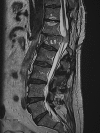Objective demonstration of improvement of neurogenic bowel dysfunction in a case of spinal cord injury following stem cell therapy
- PMID: 30443317
- PMCID: PMC6232283
- DOI: 10.1093/jscr/rjy300
Objective demonstration of improvement of neurogenic bowel dysfunction in a case of spinal cord injury following stem cell therapy
Abstract
Constipation in spinal cord injury patients is a frequent complication that leads to a reduction of quality of life, extensive psychological and economic strain on patients and healthcare systems. We report a 58-year-old man with an incomplete SCI secondary to L1 vertebral fracture, presented gait disorder with neurogenic bowel and bladder dysfunction. He received 300 million autologous mesenchymal stromal cells (MSC) in the subarachnoid space by lumbar puncture. After the third administration of MSC the patient had an important improvement in almost every functional scale of spinal cord injury, especially in the Krogh's Neurogenic Bowel Dysfunction scale. Our present observation supports recent clinical findings about the benefit of autologous stem cell therapy for the improvement of bowel dysfunction in patients suffering spinal cord injury.
Figures
Similar articles
-
Repeated subarachnoid administrations of autologous mesenchymal stromal cells supported in autologous plasma improve quality of life in patients suffering incomplete spinal cord injury.Cytotherapy. 2017 Mar;19(3):349-359. doi: 10.1016/j.jcyt.2016.12.002. Epub 2017 Jan 6. Cytotherapy. 2017. PMID: 28089079 Clinical Trial.
-
Intra-bladder wall transplantation of bone marrow mesenchymal stem cells improved urinary bladder dysfunction following spinal cord injury.Life Sci. 2019 Mar 15;221:20-28. doi: 10.1016/j.lfs.2019.02.011. Epub 2019 Feb 5. Life Sci. 2019. PMID: 30735734
-
Effect of quantitative assessment-based nursing intervention on the bowel function and life quality of patients with neurogenic bowel dysfunction after spinal cord injury.J Clin Nurs. 2018 Mar;27(5-6):e1146-e1151. doi: 10.1111/jocn.14198. J Clin Nurs. 2018. PMID: 29193471 Clinical Trial.
-
Bowel Dysfunction in Spinal Cord Injury.Curr Gastroenterol Rep. 2018 Aug 29;20(10):47. doi: 10.1007/s11894-018-0655-4. Curr Gastroenterol Rep. 2018. PMID: 30159690 Review.
-
Identifying and Classifying Quality of Life Tools for Assessing Neurogenic Bowel Dysfunction After Spinal Cord Injury.Top Spinal Cord Inj Rehabil. 2019 Winter;25(1):1-22. doi: 10.1310/sci18-00019. Epub 2018 Aug 7. Top Spinal Cord Inj Rehabil. 2019. PMID: 30774286 Free PMC article.
Cited by
-
Stem Cell Therapy for Spinal Cord Injury: A Review of Recent Clinical Trials.Cureus. 2022 Apr 28;14(4):e24575. doi: 10.7759/cureus.24575. eCollection 2022 Apr. Cureus. 2022. PMID: 35664388 Free PMC article. Review.
-
Current status and future perspectives on stem cell transplantation for spinal cord injury.World J Transplant. 2024 Mar 18;14(1):89674. doi: 10.5500/wjt.v14.i1.89674. World J Transplant. 2024. PMID: 38576751 Free PMC article.
References
-
- Lynch AC, Anthony A, Dobbs BR, Frizelle FA. Anorectal physiology following spinal cord injury. Spinal Cord 2000;38:573–80. October 01. - PubMed
-
- Rasmussen MM, Rawashdeh YF, Clemmensen D, Tankisi H, Fuglsang-Frederiksen A, Krogh K, et al. . The artificial somato-autonomic reflex arch does not improve lower urinary tract function in patients with spinal cord lesions. J Urol 2015;193:598–604. - PubMed
-
- Badner A, Siddiqui AM, Fehlings MG. Spinal cord injuries: how could cell therapy help? Expert Opin Biol Ther 2017;17:529–41. May. - PubMed
-
- Garcia-Arranz M, Herreros MD, Gonzalez-Gomez C, de la Quintana P, Guadalajara H, Georgiev-Hristov T, et al. . Treatment of Crohn’s-related rectovaginal fistula with allogeneic expanded-adipose derived stem cells: a phase I-IIa clinical trial. Stem Cells Transl Med 2016;5:1441–6. November 01. - PMC - PubMed
-
- Vaquero J, Zurita M, Rico MA, Bonilla C, Aguayo C, Montilla J, et al. . An approach to personalized cell therapy in chronic complete paraplegia: the puerta de hierro phase I/II clinical trial. Cytotherapy 2016;18:1025–36. August 01. - PubMed
Publication types
LinkOut - more resources
Full Text Sources




